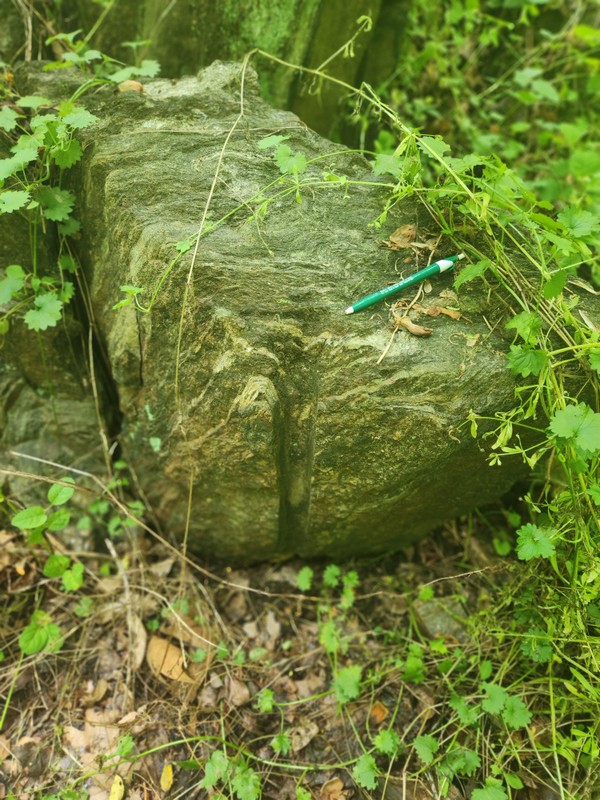Saul Preserve Points of Interest S4 Stone Quarry
Introduction
Text-to-speech Audio
Proceed about 30 yards up the Wolf Tree Trail from the Old Mill Trail. Just past the Connector Trail, on your right, you will see a very large sycamore tree and a stand of ostrich ferns. Just behind these is the Stone Quarry, mostly shist, which provided the stone for the mill dam and mill race. If you walk in about 20 feet, you will see the stone bench wall, about 4 feet tall and 12 feet wide. On the very left lower edge is a vertical score from a previous core boring of stone.
Images
Quarry Stone with Core Boring (with pen)

Quarry Stone Bench Wall (with paper)
.jpg)
Backstory and Context
Text-to-speech Audio
The Stone Quarry provided the stone for the mill dam and mill race. It may have been the source for some of the stone for the Old Mill, or the mill houses or Antrim Osbourne's own house. There were many quarries in the area, in the midst of the rich Piedmont Uplands section of southeast Pennsylvania. The quarry behind Hedgerow Theatre, across from the Old Mill, provided stone for many Will Price designed houses, including the Rose Valley Improvement Company on Porter Lane.
Surrounding areas relied on the Piedmont Uplands for quarried stone. Included were sandstone, granite, limestone, mica schist and serpentine. One of the most well known early quarries was Thomas Leiper's 1780s Lower Avondale Quarry near Crum Creek. He provided stone for Swarthmore College, and built the first railroad near Bullens Lane to move stone to Ridley Creek for transport to the Delaware River and up to Philadelphia.
Antrim Osbourne's son recalled quarryman Pat Maguigan, a "red haired Irish giant", during the 1870s. When he had a particularly hard rock to crack, he would "spit on his hands, wave his sledge over his head and bring it down with such a thump and grunt as fascinated me". He would work hard all week, drink hard on Sunday and return to work on Tuesday, "crestfallen and repentant with resolutions galore". Pat, who lived with the mill workers in the tenement (Guest House), was a glutton for hard work, and "the jolliest, gentlest creature I ever knew". Pat said the Bobbin Mill (Hedgerow Theatre) was haunted with "fairies of low and high degree". It was well known that hobos occupied the woods on the east side of Rose Valley Road.
Sources
Osbourne, Dr. Antrim Edgar. Letter to Billy Spiller, Vernon Ln, Rose Valley. . Published December 6th, 1933.
Kessler, Dr. Walt. Rose Valley Rocks: From Plate Tectonics to Architecture of Place, Rose Valley Museum. April 10th, 2022.
Peter Howell
Peter Howell
